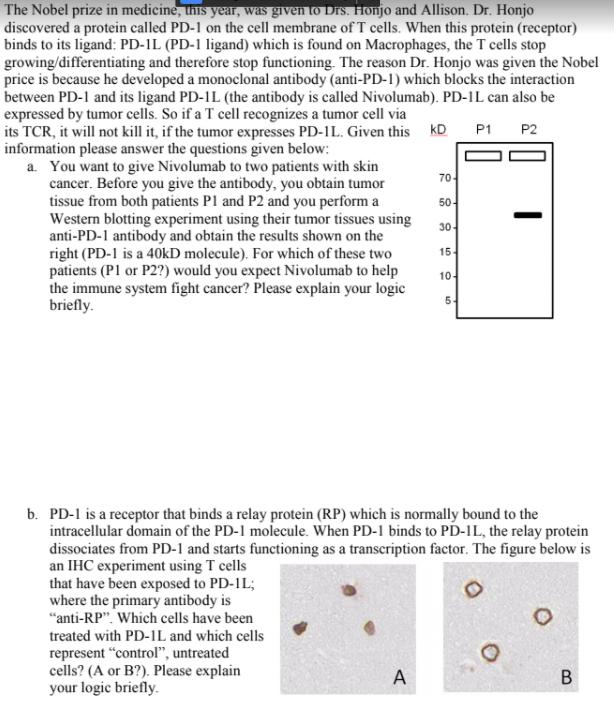Answered step by step
Verified Expert Solution
Question
1 Approved Answer
The Nobel prize in medicine, this year, was given to Drs. Honjo and Allison. Dr. Honjo discovered a protein called PD-1 on the cell

The Nobel prize in medicine, this year, was given to Drs. Honjo and Allison. Dr. Honjo discovered a protein called PD-1 on the cell membrane of T cells. When this protein (receptor) binds to its ligand: PD-IL (PD-1 ligand) which is found on Macrophages, the T cells stop growing/differentiating and therefore stop functioning. The reason Dr. Honjo was given the Nobel price is because he developed a monoclonal antibody (anti-PD-1) which blocks the interaction between PD-1 and its ligand PD-1L (the antibody is called Nivolumab). PD-1L can also be expressed by tumor cells. So if a T cell recognizes a tumor cell via its TCR, it will not kill it, if the tumor expresses PD-1L. Given this information please answer the questions given below: KD P1 P2 a. You want to give Nivolumab to two patients with skin cancer. Before you give the antibody, you obtain tumor tissue from both patients P1 and P2 and you perform a Western blotting experiment using their tumor tissues using anti-PD-1 antibody and obtain the results shown on the right (PD-1 is a 40kD molecule). For which of these two patients (P1 or P2?) would you expect Nivolumab to help the immune system fight cancer? Please explain your logic briefly. 70- A 50- 30- 15 10- 5- b. PD-1 is a receptor that binds a relay protein (RP) which is normally bound to the intracellular domain of the PD-1 molecule. When PD-1 binds to PD-IL, the relay protein dissociates from PD-1 and starts functioning as a transcription factor. The figure below is an IHC experiment using T cells that have been exposed to PD-1L; where the primary antibody is "anti-RP". Which cells have been treated with PD-IL and which cells represent "control", untreated cells? (A or B?). Please explain your logic briefly. B The Nobel prize in medicine, this year, was given to Drs. Honjo and Allison. Dr. Honjo discovered a protein called PD-1 on the cell membrane of T cells. When this protein (receptor) binds to its ligand: PD-IL (PD-1 ligand) which is found on Macrophages, the T cells stop growing/differentiating and therefore stop functioning. The reason Dr. Honjo was given the Nobel price is because he developed a monoclonal antibody (anti-PD-1) which blocks the interaction between PD-1 and its ligand PD-1L (the antibody is called Nivolumab). PD-1L can also be expressed by tumor cells. So if a T cell recognizes a tumor cell via its TCR, it will not kill it, if the tumor expresses PD-1L. Given this information please answer the questions given below: KD P1 P2 a. You want to give Nivolumab to two patients with skin cancer. Before you give the antibody, you obtain tumor tissue from both patients P1 and P2 and you perform a Western blotting experiment using their tumor tissues using anti-PD-1 antibody and obtain the results shown on the right (PD-1 is a 40kD molecule). For which of these two patients (P1 or P2?) would you expect Nivolumab to help the immune system fight cancer? Please explain your logic briefly. 70- A 50- 30- 15 10- 5- b. PD-1 is a receptor that binds a relay protein (RP) which is normally bound to the intracellular domain of the PD-1 molecule. When PD-1 binds to PD-IL, the relay protein dissociates from PD-1 and starts functioning as a transcription factor. The figure below is an IHC experiment using T cells that have been exposed to PD-1L; where the primary antibody is "anti-RP". Which cells have been treated with PD-IL and which cells represent "control", untreated cells? (A or B?). Please explain your logic briefly. B
Step by Step Solution
★★★★★
3.34 Rating (157 Votes )
There are 3 Steps involved in it
Step: 1
Question For question a the answer is P2 since P2 only expresses t...
Get Instant Access to Expert-Tailored Solutions
See step-by-step solutions with expert insights and AI powered tools for academic success
Step: 2

Step: 3

Ace Your Homework with AI
Get the answers you need in no time with our AI-driven, step-by-step assistance
Get Started


